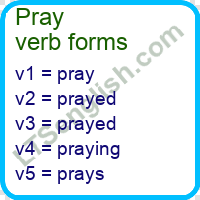Pray Past And Past Participle Form V1 V2 V3 V4 V5 Form of Pray
Have you ever found yourself wondering about the different forms of the verb “pray”? Understanding the variations of verbs is crucial for mastering any language, especially when it comes to communicating effectively and accurately.
This blog post will unravel the mystery behind the past and past participle forms of “pray”—the V1, V2, V3, V4, and V5 forms. By the end of this article, you’ll have a clear grasp on how to use “pray” in all its forms, enhancing your writing and speaking skills.
Stick around, and you’ll discover tips and tricks that can make learning English verbs feel like a breeze. Plus, you’ll gain confidence in using this verb correctly in any context, whether you’re writing an essay, a prayer, or a casual note. Let’s dive in and simplify the complexities of verb forms, turning them into tools you can use effortlessly.

Credit: ltsenglish.com
Forms Of Pray
The word “pray” is a verb. It has different forms used in sentences. These forms are known as verb forms. Each form serves a different purpose.
| Form | Example |
|---|---|
| V1 | Pray |
| V2 | Prayed |
| V3 | Prayed |
| V4 | Praying |
| V5 | Prays |
Each form has a special use. V1 is the base form. V2 is the past form. V3 is the past participle. V4 is the present participle. V5 is the singular form for he, she, or it.
Past And Past Participle Of Pray
The word “pray” is a verbthat many use often. In its past form, “pray” becomes “prayed.”This means someone already prayed. The past participle is also “prayed.” It is used in perfect tenses. People pray in different ways. Some pray every day. Others pray on special days. Praying is a way to feel calm. It connects people to their beliefs. Each form of “pray” helps tell a story. When you know these forms, you use the word correctly. Practice them to remember. Everyone can learn and use them well.
Usage In Different Tenses
The word “pray” changes in different tenses. In present tense, it is “pray”. This is the basic form. In past tense, it changes to “prayed”. The action happened before now. For past participle, it is also “prayed”. It is used with helping verbs. In present continuous tense, the form is “praying”. It means the action is happening now. Future tense uses “will pray”. It shows the action will happen later. These forms help in writing sentences correctly. Each form has a special use in sentences. Knowing these forms is important. It makes writing clear and correct.

Credit: www.youtube.com

Credit: englishgrammarhere.com
Conclusion
Understanding the forms of “pray” enhances your English skills. Simple and regular practice helps. Use “pray” in sentences to gain confidence. Remember the V1 to V5 forms: pray, prayed, prayed, praying, prays. Familiarity with these forms improves communication. Practicing these forms can make conversations smoother.
Non-native speakers benefit greatly from this knowledge. Consistent use leads to better language proficiency. Keep learning and practicing. Your efforts will pay off. English becomes easier with each step. Use what you’ve learned today. Keep going, and soon it will feel natural.






